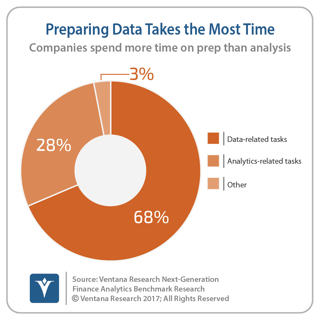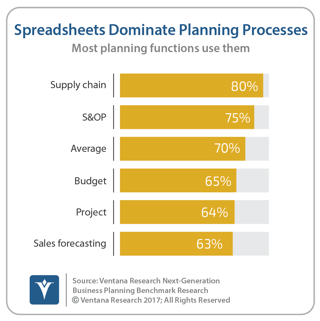Continuous Planning Promotes Action, Accuracy and Agility
Continuous planning is a term Ventana Research uses for a high participation, collaborative, action-oriented approach to planning built on frequent, short planning sprints. This enables organizations to enhance the accuracy of their plans because refinements are made at shorter intervals. Short planning cycles enable companies to achieve greater agility in responding to market or competitive changes. “Continuous” also means continuous across the entire organization – planning as an ongoing collaborative dialogue that brings together finance, line-of-business managers and executives. And because it’s high-participation planning and not silo-based, companies can plan with greater accountability and coordination in their operations. This ongoing dialog tracks current conditions as well as changes in objectives and priorities that are driven by markets and the business climate. Continuous planning promotes a forward-looking mindset in planning and reviewing that’s focused on performance improvement.
Continuous planning involves all the forward-looking activities in which companies routinely engage. Companies do a lot of planning. They plan sales and determine what products and services they will offer, what these will cost and what they will charge. They plan the headcount they’ll need to run the business and how to organize distribution and their supply chain. They also produce a budget, which is a financial plan. People and businesses plan to be successful.
In the dictionary planning is defined as the process of creating a detailed formulation of a program of action to achieve some overall objective. But it’s more than that. The process of planning involves discussions about objectives and the resources and tactics that people need to achieve them. Planning, when it’s done right, is the best way to get everyone onto the same page to ensure that the company is well organized and that it executes the plan in a way that’s aligned with its strategy.
That means coordinating planning. Setting and adjusting the company’s course requires coordination. Information technology has the potential to coordinate business planning so it’s more useful for the entire business, enabling it to improve a company’s performance and increase its competitiveness.
There’s another aspect to continuous planning. Financial planning and analysis groups spend too much time on repetitive, mechanical tasks that add little value. Our research finds that two-thirds (68%) of the participants in our Finance Analytics benchmark research spend the  biggest portion of their time doing data preparation. Only 28 percent spend the bulk of their time doing what they’re most qualified to do: analyze. Continuous planning is an approach that uses information technology to significantly reduce the need for data preparation so that business analysts in all parts of the business can do more of the valuable analytical work.
biggest portion of their time doing data preparation. Only 28 percent spend the bulk of their time doing what they’re most qualified to do: analyze. Continuous planning is an approach that uses information technology to significantly reduce the need for data preparation so that business analysts in all parts of the business can do more of the valuable analytical work.
Continuous planning is continuous across an enterprise, allowing a more integrated approach to planning. Easier than putting up with a set of siloed plans, continuous planning brings together all the operational and financial plans of a company. Our Next Generation Business Planning research shows that this approach works well. There’s a strong correlation between how well a company’s planning processes work and the degree to which plans are integrated. Two thirds (66%) of companies that have planning information directly linked also have a planning process that works well or very well, whereas only 40 percent of those that copy and paste data from one system to another can say that. And just 25 percent of those that have no linkage at all have a process that works well or very well.
Especially in larger companies, fragmented, silo-based planning efforts stand in the way of making their planning processes more effective. Our research shows that companies react  too slowly to changing market conditions. They miss opportunities to sell more. They wind up allocating resources to less productive or less profitable activities.
too slowly to changing market conditions. They miss opportunities to sell more. They wind up allocating resources to less productive or less profitable activities.
One reason for the fragmentation is technology: A majority of companies use desktop spreadsheets to manage their planning. Desktop spreadsheets encourage siloed planning and budgeting because collecting data from multiple departments – each with its own planning system and structure – is difficult and time-consuming. Our research finds that across the various functional groups, spreadsheets dominate planning. Because of their technological limitations, spreadsheets cannot support a continuous-planning methodology.
Another important benefit of continuous planning is that plans can be more relevant. Companies that have short planning cycles can update their plans more frequently than those that take longer because there’s only a limited amount of time that companies will devote to planning. Our research has found that a lack of relevance is pervasive across enterprises. Fewer than half of companies reported that their workforce plans remain relevant over their planning period. Only 45 percent of demand plans remain relevant, even though these typically are updated quarterly, if not monthly. The situation is much worse for the budget: only 29 percent of participants in our research said their budget remains relevant during the planning period – usually over the course of a year. What’s especially troubling about the budget losing relevance is that most often the budget is the only integrated business plan that companies have. So, as it becomes increasingly irrelevant as the year wears on, departments and executives wind up improvising. That leads to another less-than-optimal situation – a lack of coordination between business units and departments because the left hand doesn’t know what the right hand is doing or is about to do.
Most companies’ planning processes are artifacts of the constraints dictated by limitations of paper- or spreadsheet-based systems. To be feasible, continuous planning requires dedicated software that:
- Enables faster planning cycles.
- Connects all the planning activities of the business in a single environment.
- Facilitates the creation of planning models by line-of-business users.
- Provides a high degree of forward visibility and flexibility in defining all phases of the planning, analysis and review cycles.
- Gives a company’s business analysts the ability to easily model all the elements of the company’s business.
- Allows each planning unit flexibility to construct planning models that reflect their business requirements.
- Supports high-participation planning.
- Scales to the needs of the business without compromises.
- Offers in-context collaboration that facilitates rapid exchanges to sharpen plans and speed their completion.
Continuous planning also requires central storage of all planning data. This enables a company to compile individual business silo plans into a company-wide view and review actuals to plan in detail. Today, as our research shows, planning models and data reside in desktop spreadsheets scattered across individual computers and file servers. In addition, some of the data for planning and review processes may be in enterprise systems other than a company’s ERP systems, such as sales forecasts in a CRM- or supply-chain management system. Manually pulling together these individual strands on a regular basis is time-consuming, especially if this integration is done in a desktop spreadsheet.
Not having data limits the effectiveness of business planning. This is an important issue: only 12 percent of participants in our research told us that they have all the data they need to understand the trade-offs they’re assessing in putting together their plan. Another 30 percent said they have most of the numbers. But more than half (57%) are either unable to measure those trade-offs or have only a limited ability to do so. Businesses need a central data store of the most up-to-date information that includes actual and planned amounts. The data must be accessible in a way that makes it usable and understandable to business analysts. That way, when people in one part of the organization pull together a plan, they can access the data and plans of another part of the business that may have an impact on their projections.
Companies today can fundamentally improve how they plan using information technology to connect their usually disjointed and disconnected planning. They can spend less time planning and get better results. They can achieve greater planning accuracy and adapt faster as business conditions change. Using the right information technology that supports the integration of planning processes and planning data makes this possible. I recommend that companies – and FP&A organizations in particular – do an assessment of their planning and budgeting processes to determine the benefits of a continuous-planning approach.
Regards,
Robert Kugel
Senior Vice President Research
Follow me on Twitter
and connect with me on LinkedIn.

Robert Kugel
Executive Director, Business Research
Robert Kugel leads business software research for ISG Software Research. His team covers technology and applications spanning front- and back-office enterprise functions, and he runs the Office of Finance area of expertise. Rob is a CFA charter holder and a published author and thought leader on integrated business planning (IBP).









